How To Find Apollo 11 Landing Site
Find the Apollo landing sites
Between July 1969 and December 1972, 6 Apollo missions successfully touched down on the lunar surface. Although the mission remnants cannot exist seen from Earth, this short guide – scroll down – tells you how yous can locate the landing site areas.
- Don't accept a telescope? Take a become online with this zoomable Moon map!
- Come across even closer images of the landing sites by NASA'south Lunar Reconnaissance Orbiter
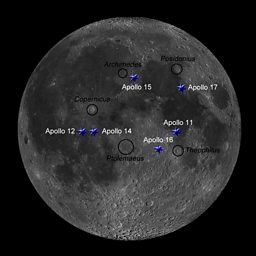
Apollo xi – Landed 20 July 1969
The first mission to land flesh on the Moon was Apollo eleven, touching downward in the Body of water of Tranquility.
- Look for the largest nearby crater, Theophilus.
- Post-obit about directly northward will lead y'all to the smaller only distinct crater, Moltke.
- The landing site is situated just north-west of the crater.
- For bonus points see if you tin can locate the three small craters, Armstrong, Collins, and Aldrin, named subsequently the Apollo 11 astronauts.
- The two moonwalkers were Neil Armstrong and Buzz Aldrin, with Michael Collins in lunar orbit.
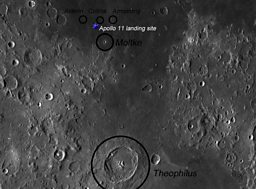
Apollo 12 – Landed 19 Nov 1969
The second mission landed in the Ocean of Storms, within walking distance of the Surveyor 3 probe.
- Locate the big crater Copernicus.
- Look south-west to the deep ringed craters Reinhold and Lansberg.
- The Apollo 12 landing site forms a rectangle with these two craters and Gambart A.
- The two moonwalkers were Pete Conrad and Alan Bean, with Dick Gordon in lunar orbit.
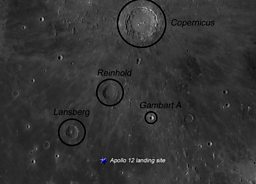
Apollo 14 – Landed 5 Feb 1971
After the failure of Apollo 13, all eyes were on the Apollo 14 mission, which touched down in the Fra Mauro germination.
- Wait for the big crater Ptolemaeus and locate the Herschel crater just above it.
- Travelling west by north-westward should lead yous to the crater, Lalande.
- Drawing a straight line from the centre of Herschel crater through the south edge of Lalande crater and travel 1.5 times the distance again to accomplish the Apollo 14 landing site.
- The two moonwalkers were Al Shepard and Ed Mitchell, with Stu Roosa in lunar orbit.
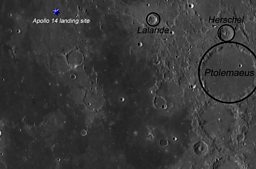
Apollo 15 – Landed thirty July 1971
Apollo 15 landed alongside Hadley Rille and was the first mission to utilise the lunar rover.
- Find the crater Archimedes.
- Draw a line from the centre of Archimedes south-east perpendicular to the bright Apennine Mountains.
- Jump n-due east to the side by side alcove in the mountain range to find the Apollo 15 landing site.
- If you lot are able to resolve Hadley Rille (the sinuous feature) yous can follow it north to where it sharply bends west to find the spot more precisely.
- The two moonwalkers were Dave Scott and Jim Irwin, with Al Worden in lunar orbit.

Apollo 16 – Landed 21 April 1972
Apollo 16 was the first mission to country in the lunar highlands, in the Cayley Germination.
- Begin by locating the crater, Theophilus (the same crater to find Apollo 11).
- Look w to the next large crater, Kant, and travel beyond the same distance again to find the small crater Dolland E.
- Looking directly north a small altitude from Dolland E will lead you to the Apollo 16 landing site.
- The ii moonwalkers were John Immature and Charlie Knuckles, with Ken Mattingly in lunar orbit.
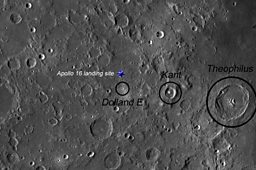
Apollo 17 – Landed xi December 1972
The final Apollo mission, number 17, landed in the Taurus-Littrow Valley.
- Find the oblong crater, Posidonius.
- Travel south past southward-eastward to discover Le Monnier, Littrow and then Vitruvius crater.
- Apollo 17 landed in the dark valley between Littrow and Vitruvius.
- The two moonwalkers were Gene Cernan and Harrison Schmitt, with Ron Evans in lunar orbit.
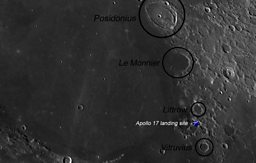
Source: https://www.bbc.co.uk/programmes/articles/3gDG023plXCJLVpvHZ8qtBf/find-the-apollo-landing-sites
Posted by: knightwoust1984.blogspot.com

0 Response to "How To Find Apollo 11 Landing Site"
Post a Comment